— Where does the body shape come from?
— How do cells in the body know what to become?
— Is it true that complex anatomy is impossible without a designer?
In the beginning, there’s always a single cell…
… which eventually divides into thousands of daughter cells and gradually molds into an adult organism with every organ in the right place. Every cell just miraculously takes its role to produce perfect shape and function.
But how? How can a bunch of identical cells suddenly go different paths and express different genes? It’s not like the cells can observe the whole embryo from afar via some satellite imaging and think: “Uh-uh, I’m right above those two cells, so I shall become an eye!” Nor there’s a dude standing nearby with a blueprint in his hands and orchestrating the whole process.
A cell is just a chemical system. Nothing more. Two identical cells will always follow the same developmental paths no matter what: they can’t just arbitrarily decide to do elsehow. So, to act differently, the cells themselves must be made different from each other – for example, in their chemical composition.
Different chemical composition ⟶ Different gene expression ⟶ Different cell fate
Now let’s take a look at the adult’s body plan. Firstly, it has well-defined top and bottom that are different from each other: the body is vertically asymmetrical.

Secondly, the organism is horizontally symmetrical, but notice how its arms and ears grow from the outer cells but not the inner ones: although the horizontal symmetry is there, the body is horizontally differentiated on the “towards midline / away from midline” basis.
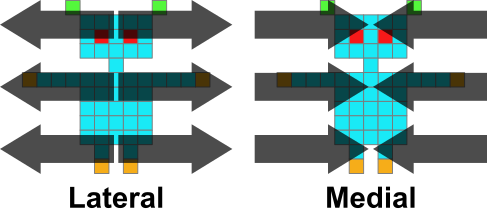
Here’s how to trigger differentiation both horizontally and vertically:
- A bag of some substance is placed at the very top of the embryo cell.
- The bag releases the substance to gradually diffuse throughout the cell away from the top.
- At the same time, the cell synthesizes another substance near the nucleus to diffuse throughout the cell away from the center.
The cell ends up with gradients of two substances. Yellow is distributed away from the top: it’s the vertical symmetry breaker that gives the cell “the sense” of up and down. Green is distributed away from the centre and gives the cell “the feeling” of inside and outside.
- Finally, the cell divides.

Different amounts of the two substances end up trapped in different daughter cells. Two overlapping gradients become two overlapping grids, with each cell having its own concentrations of the two substances:
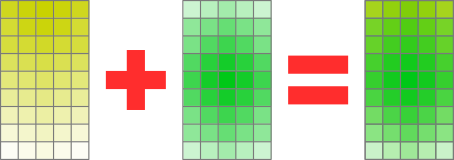
It’s a coordinate system, where every cell is defined by two values: the concentration of yellow, and the concentration of green.
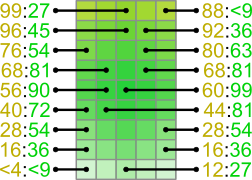
Notice how all cells have different values except horizontally symmetrical ones — exactly as intended. From now on, cells can go on and differentiate according to their position.
Every cell now “knows” where it is.
Q: How exactly does the differentiation happen?
Basically, it’s sort of a programming language, where a cell acts out only when specific conditions are met:
- If a cell has between 88% and 92% of yellow, and between 30% and 40% of green — then trigger eye development;
- If a cell has between 62% and 72% of yellow, and between 59% and 85% of green — then trigger programmed cell death.
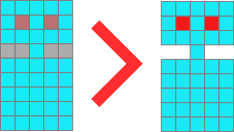
Q: Programming is programming, but how’s such intricate control achieved on the chemical level?
The yellow and green are transcription factors: special proteins that regulate the gene expression. The presence or absence of these proteins, as well as their concentrations, determine which genes will be read and which will be silenced. Combined use of several transcription factors can accurately guide the formation of body parts even as complex as limbs.
Finding limb buds is easy using the coordinate system that was introduced earlier — they are activated by specific concentrations of yellow and green:

Making them grow out and undergo further divisions is also easy: after all, that’s what cells do. But how do we make them grow out in the right direction?
As they cannot guide themselves, something from the outside must guide them and give them the “sense” of direction. That something has to be the cells immediately adjacent to them:

Firstly, four cells next to the limb buds are pre-activated: their yellow and green concentrations activate the production of another substance (blue) that fills them up and diffuses into the adjacent limb buds via the intercellular channels called gap junctions. The function of the blue is to suppress the cell growth.
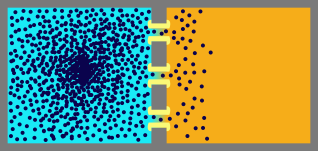
At the same time, the limb buds start growing. Since the growth suppressor is slowly diffusing through them, there’s only one direction left where they can grow — the right one. As more suppressor is being synthesized and diffused into the limb buds, their tips will continue to grow away, kinda “escaping” from the blue gradient.
The process is called polar cell growth.
After the limb bud growth is over, it can divide into daughter cells.
Now to ears. Apparently, the earbuds must undergo a single cell division. However, this division has to occur in the right direction — which means that again, the cells need some reference. And again, the adjacent cells will do the job:

The process is similar to what’s happened in limb buds: the cells by the earbuds start secreting some cell division factor that slowly diffuses into the bud via gap junctions and establishes a gradient that causes the apparatus of cell division to align in certain way.

Voila!

Q: How exactly do transcription factors work? How does a gene know to respond to specific concentrations of yellow and green?
Transcription factors activate genes by binding special regions on the DNA: unless the transcription factor is attached, the DNA reading machinery can’t access the gene.
Moreover, transcription factors have specific affinity to regulatory regions – the strength of the attraction between them. The higher the affinity, the easier a transcription factor will bind its regulatory region. Therefore, the lower the affinity, the higher concentration of the activator is required to keep the gene activated.
In the end, every gene has its own regulatory regions, and every regulatory region binds its own transcription factor with specific affinity. That’s why different genes are activated by different concentrations of specific transcription factors.

Such transcription factors that promote gene expression are called activators, and the regulatory region that it binds is called enhancer. Apart from activators, there are also repressors: instead of enabling gene expression, they halt it by binding regulatory domains called silencers.
Q: A gene won’t run unless the concentration of its activator is over certain threshold. But how are some genes activated by a range of concentration: e.g. from 50% to 60%, no more no less?
Such genes have two regulatory regions for the same transcription factor: one with higher affinity than the other.
Now, if we gradually raise the concentration of the transcription factor, it will bind the first of the two regulatory regions – the one with higher affinity – and activate the gene. But if we further raised the concentration, it will bind the second regulatory region. And the gene will be deactivated because the second regulatory region isn’t an enhancer, but a repressor.

In this case, the transcription factor will be both an activator and a repressor: it will promote gene expression at moderate concentration but shut it down at high concentration.
Q: Won’t the blue that directs the limb outgrowth also sip into cells other than limb buds?
It will, but to no effect. The regulatory pathway is a job for both participants: the signalling cell produces the blue, the receiving cell prepares to receive it and initiate outgrowth. Those cells that aren’t preparing for anything will just digest the signalling molecules.
Q: How does the limb know when to stop outgrowing?
Any complex chemical has a limited lifespan (or, more precisely, the half-life). The orange proteins that stimulate the outgrowth will eventually break down, and the outgrowth will halt. The stability of every embryonic protein has been polished by evolution for millions of years – ensuring that each of them will stay active for precisely as long as needed.
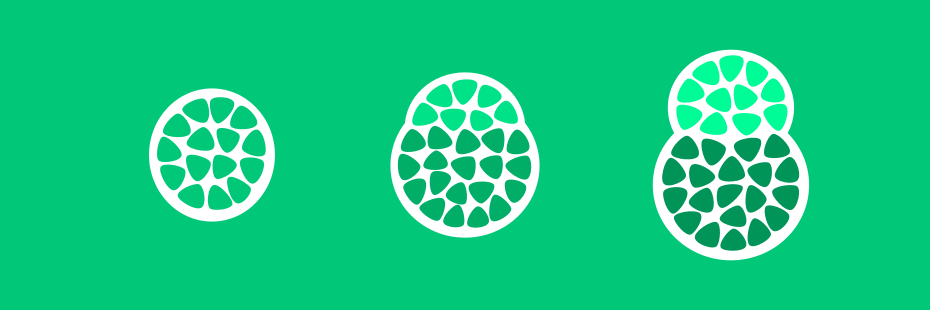
As always, we welcome any questions or suggestions.
[…] P.S. Meanwhile, asymmetry is a true art. […]